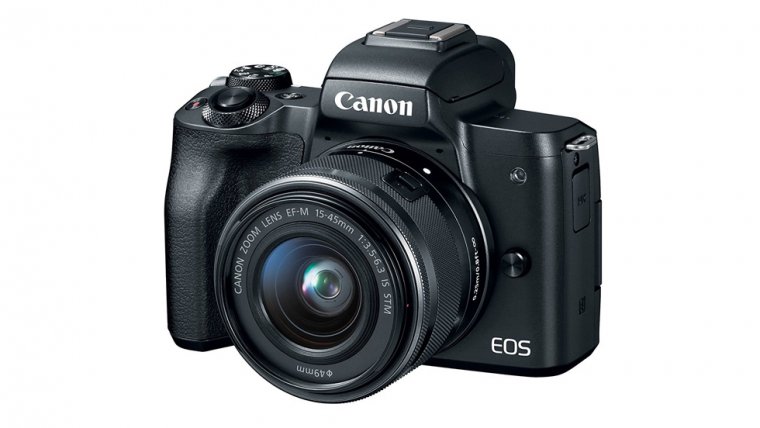
We all know the story by now: the mirrorless cameras are on the rise, while the DSLRs are on a steady downfall and that trend is showing no signs of stopping. Many companies that were early adopters of the mirrorless technology are now enjoying bigger than ever popularity while those that are still sticking with older technology and trying to cash in on its former glory aren’t having as good of a time. Those companies are the two largest DSLR manufactures in the world, Nikon, and Canon.
Nikon’s take at mirrorless cameras was their 1 series of cameras and we all know that those didn’t exactly enjoy a lot of popularity (because of smaller sensors, a limited number of available lenses and so on). Canon on the other hand also had a shaky start with their first mirrorless camera, the EOS M, which was criticized for having an unimpressive AF system and slow performance in general, but the company has managed to bounce back with the release of future EOS M models that have managed to improve on everything the first one was accused of not doing as well as it should.
Now, Canon still hasn’t been able to overtake most of the camera manufacturers in this particular category, but they are certainly getting there with each new model being released like the Canon Rebel SL2. Today, we’ll be looking at their newest offering, the one that is aimed at really shaking the market with its balanced set of features and an attractive price point. We are talking about the EOS M50, one of the best Canon cameras, a model that falls somewhere between an entry and a mid-range camera, but also tries to break some new grounds for Canon at the same time. While it bears the same sensor as the 80 and a lot of similar features to its other mirrorless brethren it does bring one feature never seen before on a Canon mirrorless camera and that’s 4K video recording. That is something that is bound to excite a lot of users that were asking this from the company for many years now, but we have yet to find out how well is it implemented on the M50 and is it as useful as you would expect it to be. Other important features include an articulating touchscreen, high-resolution EVF, fast burst rate, a microphone jack, different image stabilization solutions (albeit they are all of the digital variety), a new and improved AF system, faster processor and more. It may not be the top of the line model, but the Canon EOS M50 does seem to bring a lot to the table for its class of cameras. Still, one fact surrounding the EOS M line up does remain unchanged for the time being and that’s the rather small number of available lenses that are native to the system (you can still adopt any EF lens by using the appropriate adapter, but we all know how bulky some of those can be and it is not easy to balance them on such small mirrorless bodies).
So, if the EOS M50 turns out to be a very capable camera, then the lens situation probably won’t bother a lot of people and thus, this particular model does have a big responsibility to represent its creator in the best way possible. There’s no denying the fact that we have a very exciting review at our hands and we’re curious to see what Canon has come up with in terms of their newest mirrorless camera. As always, let us start with a roundup of its specifications.
Table of Contents
The Canon EOS M50 certainly isn’t the smallest camera in Canon’s mirrorless line up (that honor still goes to the M100) but is still quite portable for everything it has to offer. Its plastic construction won’t impress anyone with its sturdiness but was crucial to keeping the weight down to very manageable 390 grams. The hand grip on the front is deep enough to allow anyone have a very comfortable hold on the M50 and the non-slippery material featured on the grip itself and also on the back of the camera will prevent any accident that is bound to happen if you have sweaty hands and the camera became wet for any reason. Still, you should try to keep it dry as long as you can because of the lack of any weather sealing.
Design-wise, the looks exactly like a blend of Canon’s entry-level DSLR and a mirrorless camera, which is why its so easy to carry around, but also very comfortable to use. We especially like the white model, which really makes it stand out from a lot of cameras on the market that are just black slabs of black plastic or metal. In terms of the available controls, you won’t find a lot of buttons or dials here as the camera looks as clean as a modern device can look bearing only the bare essential and instead relying mostly on the input the user is bound to make via the included touchscreen unit. While it won’t be a very popular method of control to more die-hard photographers (which aren’t the target audience for this camera anyway) it will certainly appeal to more younger photographers and videographers or those that have learned to appreciate all the benefits of using a touchscreen-centered device (like our smartphones, tablets and even laptops to a certain degree). Also, Canon are already well known of being one of the best out there when it comes to creating user-friendly and intuitive user interfaces on all of their cameras and this fact really instills confidence in the M50 as another one that will be easy to use no matter your level of expertise with Canon’s cameras or dedicated cameras in general.
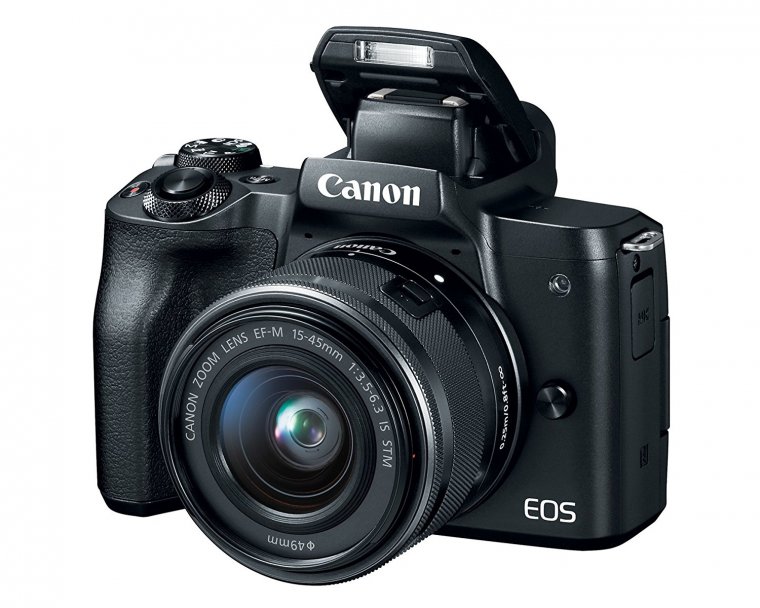
Now, no look at any camera body would be complete without taking a look at each and every detail of its design and thus its time to take the Canon EOS M50 in our hands and examine it from all of its sides. Let’s start with the front of the camera. Here we find the obligatory Canon logo and EOS marking, as well as the lens release button, a pair of stereo microphones and the AF assist/Self-timer lamp. Both the sides of the camera hold your standard strap mounts but only the left side itself comes equipped with the external microphone jack and the NFC mark, while the right side holds the micro-USB and the micro-HDMI ports, as well as the dedicated Wi-Fi button. The tripod socket and the Memory card/battery cover are located on the bottom of the camera, as is usually the tradition. The top of the M50 houses the focal plane mark, the pop-up flash, the M-Fn (Multi-function button), the main mode dial, the power switch, the Movie button and lastly, the shutter button itself which also features the main control dial. In the end, let us check what can be found on the back of the EOS M50. Aside from the familiar things like the touchscreen and the EVF you should also notice a small LED indicator and a large array of different buttons including the AE lock/Magnify, AF point selection/Index, Info, Playback and Menu buttons and the four-way navigation button with four shortcuts mapped to each of its directions (AF/MF, Exposure compensation, Flash and Single-image erase) and one Quick Control/Set button located in its center. So, if you’re one of the more observant or advanced users you have already probably noticed that things like the secondary control dial or a dedicated ISO button are missing and that’s all due to M50’s entry-level nature. We believe that Canon intended for it to be used more as a point-and-shoot camera than a professional tool, but still capable of full manual exposure control for the minority of people that need such functionality. For that reason, we wouldn’t recommend this camera to professionals, unless they are ready to perform an extra step or two to make certain adjustments or activate some of the available functions.
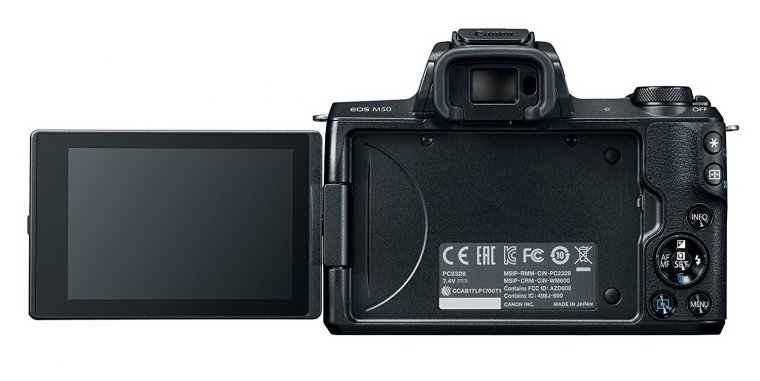
Luckily and as we’ve expected, the user interface on the M50 is your traditional Canon affair; very easy to get a grasp of, smooth in operation, nicely organized and labeled and perfectly usable with the included touchscreen. It’s quite obvious that Canon has taken the time and the effort to optimize it as much as possible for effortless navigation; especially if you’re not a stranger to using dedicated cameras, no matter if the camera in question was a point-and-shoot or a DSLR. Taking photos with the Canon EOS M50 is extremely easy if you leave the camera in its Scene Intelligent Auto Mode; you just need to power it on, press the shutter button and you’re done. The said mode was very good in predicting the right settings that should be used for different types of lighting (at least from our testing) and manages to mimic something like a smartphone shooting experience very nicely (as many of our modern phones tend to do a fantastic job of providing satisfactory photos even without any input from the user). In addition to that mode, there’s also another interesting one called the Hybrid Auto Mode. This one will allow you to record short video clips before you take any of your photos and combine them into one digest movie of, making it an easy way to create a compilation of all your daily doings.
We also like the addition of many different types of Shooting information that can be overlaid over your screen as you can either decide to keep the information shown to the bare minimum or get a full array of all the exposure readings and currently active settings and functions. Those of you inclined on spending time on adjusting all of the available settings (especially the ISO, shutter speed and aperture) will surely spend a lot of time inside the Quick Control Screen, which is a nicely laid out main collection of all the important functions that can be easily accessed at any time with the use of the Quick Control/SET button. You can either use the navigation controller and the control dial to navigate through its items or you can simply use the familiar touch gestures we all know and love; both methods are very effective, again, thanks to the very well executed user interface and the menu system. Still, despite working perfectly as a simple camera to take great photos with it does show it’s somewhat cheerful and entry-level nature when it comes to the amount of customization available as there is nothing worthwhile to report on for this matter.
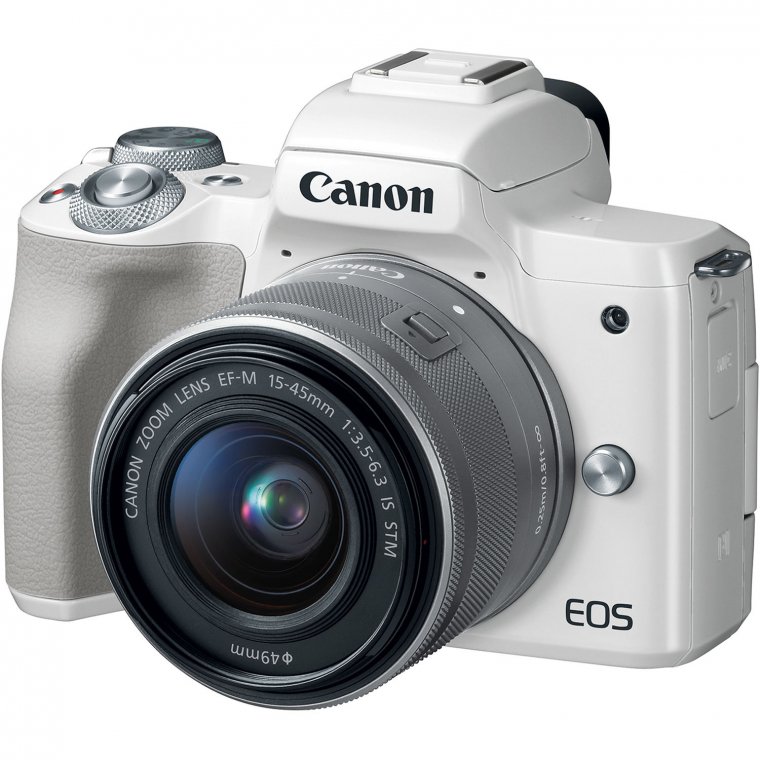
While you’ll be able to set up a few things here and there, the M5 doesn’t come near to a more advanced camera in terms of customizing the user interface, buttons, dials, custom shooting modes and so on. What you see from the first minutes you spend with is what you’ll be seeing the entire time using it. Now, while it may be something that more enthusiastic users out there won’t appreciate, in all honesty, it won’t bother most of the people that decide to buy it since it works well as a camera without any additional adjustments having to be made for it to function properly.
On the very positive side, Canon decided not to skimp on giving the M5 all the necessary connectivity features as it certainly presents itself as a very capable device in that regard. Most of them are centered around connecting it to a smart device (a smartphone or a tablet), but you can also pair it with a computer (control it remotely with the help of the EOS Utility application or automatically back up your images via the Image Transfer Utility 2 program), connect it to a PictBridge compatible printer or upload your images directly to a Web service of your choice or back them up using the CANON iMAGE GATEWAY cloud storage service. Those that want to make use of all the features that require the use of a smartphone or a tablet will need to download the Camera Connect application (available both for iOS and Android devices) and use either the Bluetooth, NFC or Wi-Fi to establish the required connection (to find out more information about all of those options we advise you to take a peek at the brilliantly designed official manual available online). After you’ve gone through all the necessary set up procedures you’ll be given access to things like image transfer, remote control and geotagging (all of the features you’d expect to find on a modern camera).
We certainly like that Canon has put a lot of emphasis on the remote-control function as you’ll be to play around with everything like AF and White Balance options to manual exposure controls. So, in a nutshell, the Canon EOS M50 is a well-rounded camera that perfectly fits into the beginner and entry-level mirrorless camera market. It sports nice build quality, excellent user interface heavily reliant on the use of a touchscreen, great shooting options to help those buying their first camera to get a grasp of photography and all of its charms, very capable articulated LCD screen and the EVF and lastly, an extensive set of wireless capabilities that could be a perfect fit even for a more expensive camera than the M50 itself. You could fault it for not having enough physical controls and lacking in customization options, but all of these could be considered to be the aspects of a camera that’s positioned higher in the hierarchy (which can’t be said for this one).
The M50 is a simple and fun device to use and there’s certainly a large audience out there that need a camera with exactly the same behavior, thus, it wouldn’t be realistic to criticize it for some of its shortcomings.
One of the biggest improvements that the Canon EOS M50 brings to the table over its predecessor and the entire EOS M line up has to be its new AF system. While it retains the familiar Dual Pixel technology, it now brings more focus points than ever; 121 when used with selected lenses (only three of them at this point in time, the 18-150mm f3.5-f6.3, the 28mm f3.5 Macro and the 55-200mm f4.5-f6.3 lenses) and 99 points for every other EOS M or the EF mount lens. You’ll also gain an additional benefit if you decide to use one of those lenses that we’ve mentioned and that’s the much better AF coverage and increased area over the entirety of your frame. This means that the camera will have much easier time tracking any moving subjects and doing it with more precision at the same time thanks to the increase in available focus points. Still, even if you don’t manage to reap the full benefits of the new AF system, you will enjoy the best available focusing performance on any Canon mirrorless camera.
While the older 49-point system itself didn’t have much trouble even when it came to coping with more demanding conditions that involved action or sports, the new one will certainly yield you noticeably more perfectly focused shots, especially if you get to take photos of those subjects that are moving in a more unpredictable manner. We still wouldn’t rank the Canon EOS M50 amongst one of the best performers out there in terms of focusing, but it seriously punches above its weight and will give any other entry-level mirrorless camera on the market a run for its money. We would even go as far as to call it a good back up to your main camera if you’re a specialized sports shooter and you already own decent EF telephoto lenses that you can adapt to the M50 (they should work with no problems at all with the new AF system). Now, half of the power of any focusing system lies in all the available options given to the user to adjust its behavior to their own needs and the time has come to closely examine those that come preloaded within the M50’s menu system. The main focusing modes are split into three; Face+Tracking (the best one to be used for shooting people and keeping them in perfect focus even if they start to move around), Zone AF (The mode that automatically determines which AF points to use depending on your shooting conditions) and lastly, the 1-point AF (the most precise method of focusing for shooting still subjects and putting emphasis on any of their particular details). For those of you shooting portraiture, Canon has also supplied a separate Eye Detection AF mode that will try to look for people’s faces in your frame and make locking focus on their eyes a top priority.
The traditional Servo AF mode is also available, and it will allow the camera to reacquire focus each time any movement is detected, which makes it the perfect mode to be in when it comes to taking photos of wildlife, sports, action, cars on any other moving subjects. Using manual focus on the Canon EOS M50 should be a pleasant experience for everyone thanks to the addition of things like Focus Peaking and frame magnification. You will also be given the option to change the color of the outlines provided by Focus Peaking and also adjust its level of sensitivity (meaning that you can fine-tune it to behave better in low light than good light and vice versa).
While we wouldn’t expect or an entry-level camera to perform as good as a flagship or even a mid-range camera in terms of its general responsiveness, power-on times, shooting speed or buffer clearing times, the manages to hold its own against the more expensive cameras and brings a very satisfactory experience for all of the operations stated above. Even the more demanding users out there should have no reason to call the M50 a camera that doesn’t respond well to any of the inputs from the user and you certainly won’t hear us complain about that. The same can be said for its burst rate (even though it’s not the most impressive one we’ve ever come across any mirrorless camera). You’ll be giving the option to shoot either at a speed of 10 fps and with the focus being locked at your first shot or at 7.4 fps with the Continuous AF enabled. If you’re primarily a JEPG shooter than you can expect to get very decent buffer depths sitting around 33 shots at the fastest and 47 at the slower shooting speed. Sadly, switching to RAW degrades the performance considerably and will bring you down to 10 or less shots in any of the available modes and thus you should consider sticking to taking only JPEGs if you want to get good results and capture any moving subjects.
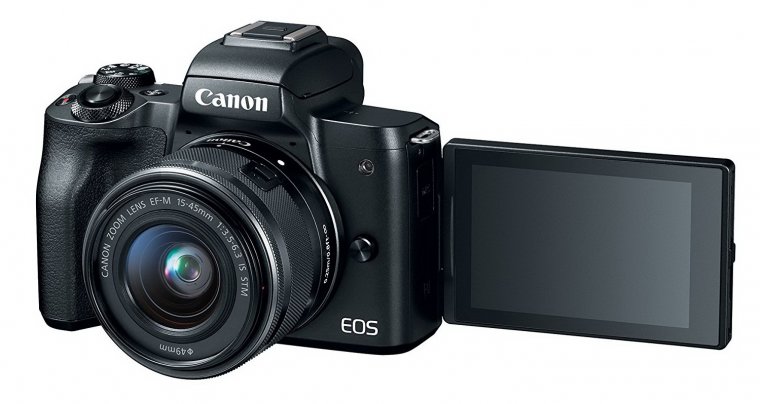
We couldn’t really fault the M50 too much for its RAW performance since we are talking about an entry-level camera, but there is one black mark to this camera’s overall performance and that is its battery life. While it does come with features like Eco or power saving modes (which won’t be useful to everyone considering the caveats they tend to bring for increasing the endurance), the standard rating of only 235 shots is just too low to be useful to anyone other than the most casual photographers taking a couple of pictures here and there and maybe recording a few minutes of video footage (especially if it’s in the 4K resolution). We would recommend you to order an extra battery pack or two if you’re at least somewhat serious about photography if you decide that the Canon EOS M50 is the right camera for you.
Other than the obvious complaint we have about its battery life, the M50 is really doesn’t show any noticeable weaknesses that would ruin its focusing performance and the overall usability. It behaves as good as an entry-level camera can and even better than that in some regards; we are certainly satisfied with everything we’ve seen during our review.
So, a whole lot of buzz has been surrounding the Canon EOS M50 from the very first day it was announced and the main reason for that has to be its video recording capabilities. Everyone from Canon’s dedicated fanbase to camera reviewers like us were craving for Canon to release a mirrorless camera that will finally bring the needed video production features to be able to compete in the same league with the likes of Fujifilm, Panasonic, Olympus, and Sony.
The M50 is the closest the company has ever been to give their competition a run for their money, but they still remain one step behind them even though they’ve come one step closer. Aside from the expected 1080p 60 fps mode, Canon’s newest model finally breaths in a new life into the entire line up by bringing 4K 30 fps recording to the table and we can certainly happy to see that things are finally going forward for the EOS M cameras. The addition of an advanced digital stabilization modes that can also work together with the hardware stabilization built into any of the EF-M or the EF mount lenses is also nice to see and so is the addition of features like Focus Peaking, Dual Pixel AF, the microphone jack and also the always useful articulating touchscreen LCD, but most of these features bring a caveat of their own that you won’t be aware of until you start to dig in a little deeper and educate yourself about the M50. First, there’s the video quality.
While both the 1080p and the 4K footage that comes out of this camera looks pretty good for modern standards, it’s still not up to par with other cameras on the market bearing similar features. While the M50 is able to record its 4K videos at a respectably high bit-rate of 120 Mbps their quality is seriously impacted by the significant crop that’s applied to those videos (especially if you enable any of the available IS modes). This essentially means that the M50 isn’t using its entire sensor while recording in 4K and uses only a portion of it and naturally a drop in sharpness and the increased amount of noise can be observed in some situations. While you probably won’t notice them while shooting in daylight, you will in more dimmer conditions. Secondly, the mighty Dual Pixel AF technology that has been praised a lot by the photographic community doesn’t work in 4K mode and leaves the camera to rely on the less impressive contrast detect method of focusing. While you shouldn’t have too many problems with its absence if you’re recording still subjects or using the tap to focus feature, making movies or anything else will give you less reliable results.
You could also criticize the M50 for its lack of S-log profiles, the headphone jack or the Zebra patterns, but that would be unfair considering its entry-level nature. Now, it may sound like we’re judging the Canon EOS M50 a bit too harshly on the merit of its video recording capabilities, but we’re not. We are trying to stay as objective as possible. The M50 certainly is an all around great camera for less demanding users wanting to record good quality videos, it’s just not a very good 4K camera.
We certainly appreciate Canon for finally coming to their senses in stopping resting on their laurels and finally trying to make some serious impact on the modern camera market with one of their mirrorless cameras, but just aren’t there yet and need to make that final step to really hit the market hard. All in all, if you want a good 1080p camera for not much money, the M50 will fill that purpose absolutely fine, just don’t expect to do any kind of wonders with is 4K mode.
Now, while we were certainly able to find some faults with the M50 and its movie mode, the story is entirely different as such as we switch to talking about its ability to capture photos. The M50 is as good at producing still as any other of Canon’s APS-C cameras on the market and even better than them when it comes to making the most out of its JPEGs. The 24 megapixels is still the sweet spot resolution for these types of cameras, providing an abundance of detail when paired with a decent lens and not giving the sensor a hard time with providing good dynamic range and noise performance. It actually has the same megapixels as Sony’s Alpha A7.

Photo courtesy of Jean-Pierre Perroud
Shooting in RAW will allow you to pull a healthy amount of details from your shadows in post-processing if they end up being underexposed (recovering overblown highlights is a little trickier, but that can be said for every other camera out there) and also shoot at ISO values of up to 6400 without having to deal with unusable photos. The new and more powerful Digic 8 processor did enable Canon to slightly tweak and improve the JPEG processing and thus, those of you not interested in shooting in RAW will be happy to know that the M50 is able to produce really good pictures out of the box, even in more challenging low light conditions. Also, if you’re inclined to playing around with different effects and filters, Canon has also got you covered there. There’s an abundance of them available including the HDR (in more than one variation), Monochrome, Soft Focus, Fish-eye and more. Interestingly enough, those can also be applied to your videos, which is certainly a nice bonus feature.
So, the M50 may not be breaking any grounds in terms of its stills quality, but it brings a satisfactory level of performance that will surely satisfy anyone that decides to make it a new addition to their photography gear (even if they consider themselves to be more than a beginner or amateur photographers).
Well, it’s certainly never easy to review a Canon camera. The reason for that is the high expectations we always tend to have for such a well-established brand and the company often being reluctant of adopting new technologies and playing the safe game for too long. The EOS M50 presents itself as one of those products that acts a sort of a saving grace for a company such as Canon, bringing in a new hope for the better future of their devices and making their loyal users feel more appreciated for supporting them for so long and turning them into a familiar corporation they are right now.
Canon have created a solid entry-level camera that manages to combine good photo and video quality with things like a touchscreen and the EVF, excellent user interface, very good performance and capable AF system, portable and well-designed body and so on, but have also taken a risk at including a 4K video mode that just doesn’t cut it when compared to everything the competition has achieved. It’s a shame that the one headline feature that could make the M50 even a better camera is left so underutilized and undercooked, feeling more like a science experiment than anything else. We still have a very capable mirrorless camera at our hands that would make a lot of amateur photographers and videographers happy with everything it has to offer, but not because it has 4K recording included as that is not the main reason you should have for considering the M50 as your next camera.
So, if you want an all-around solid entry-level camera and you’re happy with only shooting at 1080p most of your time, then you should have no reason not to look at this one and love it for a lot of good and useful features it comes equipped with.
Comments (0)
There are no comments yet.